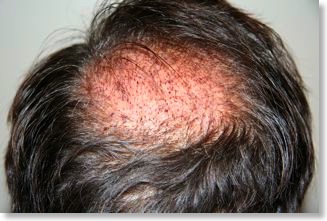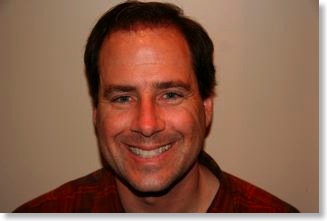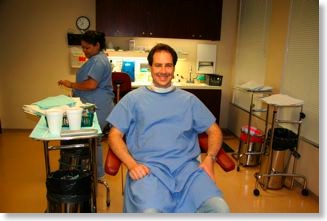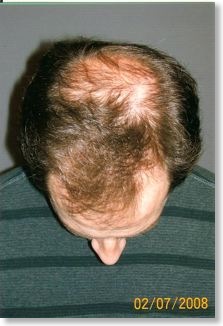Day 10 After Hair Transplant Procedure - Suture Removal
A few hours ago I had my sutures removed. The last few days they were really bothering me when I laid down on a pillow. It was more of an annoyance than anything along the lines of an ingrown hair. So they take out the stitches which are very thin blue threads. It's amazing how irritating something so small can be.
I was told that people that heal quickly are usually finished healing at day 10 but slower healers take 14 days which is why Bosley says to wait at least 14 days before any activities. I think I'm healed but I can wait another 4 days. I can't wait for a regular shower and to be able to comb my hair!
If you have read the previous entries, you will notice that I didn't complain about a lot of itching. I forgot to mention that the day before the procedure, I applied Diprolene, a topical steroid that eliminates dermatitis, on my entire scalp. I figured it would be a way to alleviate any itching that would occur. I think it worked. Now, I can't prove it worked, but a symptom of this procedure is a lot of itching during the healing process. I had almost none. I recommended to Jose, my suture remover, that he pass that along to the doctors as it might be a good thing to include as part of the standard regimen if they can show it to work.
One other observation is 99% of any pain I had was related to the suture itself and not the transplanted hair on the rest of my scalp. When Bosley perfects the hair cloning process that they are working on, this procedure should get a lot better as the donor hair won't be required except for a little spot for the donor hair to be cloned. This small piece of skin and hair will be taken and healed way before your actual procedure. The real pain of this procedure will be with the initial anesthesia injections and that is about it.
Day 3 After Hair Transplant Procedure
Today was a great day! I woke up after my first full night of sleep and there was minimal pain. As a result, I didn't need to take any Vicodin today. I did take the Methylprednisolone before breakfast and after lunch as directed. I have two more days and then it will be gone.
I am experiencing a little more itching as things heal up. I can't scratch but I was told that I could gently touch the area but don't rub it. It seems to work pretty well. When I touch the transplanted area, I feel all of the little stubble from each hair. It feels pretty neat.


Today, my scalp doesn't look any worse than a bad sunburn. It does, however, feel tight since the skin was stretched slightly to close up the donor area. For the last two days, my scalp has been getting very oily. It's probably just a by-product of the healing process. I definitely need to wash my hair every night. It's a delicate process where I mix the shampoo with water in a cup and then gently pour it over my head. I then pour clean water to rinse it. It doesn't seem like much but it actually removes that oil. The problem is, I can't really comb it too well for another 10 days. That will be a great day!
Time to take my last Methylprednisolone for today. I'm going to try the bed tonight so I need to take the Vicodin. I want to at least lay my head down without any pain.
Day 2 After Hair Transplant Procedure
I almost made it through the night. At 5:30 AM I woke up in pain again and had to take another Vicodin. After about 20 minutes it started to kick in and I slept for about 3 more hours. When I awoke, I turned on the TV and my doctor, David Deutsch, was speaking in a Bosley infomercial. I thought the timing was quite funny and felt lucky that I was worked on by one of their lead doctors.
The first thing I noticed today is that my head isn't as purple as yesterday. I took a Vicodin at 10 AM and that was it for 8 hours. I wanted to see if I could last without any pain medication. The answer is definitely no. Without the meds, my pain went up to a 5 out of 10. I took the Vicodin at 6 PM and the pain went away; it also made me tired.
I also noticed something else today, I have a completely numb area in the back of my head just above the center of the donor area. I'm guessing when the strip of skin was removed, some nerves went with it. I am told that they will fully regenerate within 3 months.
I can definitely see a difference in the transplant area. When the hairs are transplanted, they are very short like stubble and give the area a filled in look. These hairs will fall out within the next two weeks when they go dormant. Three months later they will start to grow. I can't wait!
I am going to take a Vicodin and a Halcion before bed tonight and I just noticed I forgot to take the Methylprednisolone yesterday (5 pills) and today (4 pills). I will take one of the 4 pills and resume the schedule per the directions on the box.
Day 1 After Hair Transplant Procedure
Last night was not a great night. I started in a bed but at about 2 AM I woke up in pain (Mike's pain scale 5 out of 10). Surprisingly, the 3002 holes in my scalp for the transplant don't bother me, but it's the suture in the back of my head. The strip of skin from the donor area was 25 cm long (10 inches) by 1 cm. Two large stitches in a cross-stitch pattern (similar to a baseball glove) are pulling the scalp back together. The local anesthesia must have worn off completely while I was sleeping as well as the Vicodin because it hurt to lay my head down on a pillow. I went ahead and took Vicodin for the pain and Halcion, a sleeping pill. I then went to a recliner chair for the rest of the night. After about a half hour, everything kicked in and I was able to get comfortable by putting a pillow under my chin and leaning my head forward. This kept all pressure off the back of my head. Once the Vicodin took hold, the pain level went to 1 out of 10.
This afternoon I went back to Bosley to get my hair washed and also to get instruction on how to wash my hair. After my hair was washed, they blotted some of the blood clots to clean me up. They told me to mix a tablespoon of Bosley shampoo in a cup of water and pour it over my head gently so as not to dislodge any of the transplants. I have to do this for 2 weeks until the hair is set.
Here are a few pictures after my hair was washed. It's purple but it doesn't look too bad.




While riding in the car to and from Bosley, I was feeling a bit nauseous and very tired. I think I might have been hungry and not realized it. Hopefully this is a one-time event; I'll make sure to eat more regularly while I'm healing.
Today's drug schedule was as follows:
Vicodin: 2:30 AM, 10 AM, 4 PM, 10:30 PM
Halcion: 2:30 AM, 10:30 PM
This time I took the Halcion before going to sleep along with the Vicodin to see I can make it through the night. I'm also sleeping in the recliner chair to start.
Day 0: The Hair Transplant Procedure
I showed up just before 7 AM at the Beverly Hills office. I checked in and signed a form that allows Bosley to take a small, 'fresh scalp' sample for research and I get $100 back. Bosley is currently trying to clone hair so that in the future only a small sample will need to be taken from a person instead of a long strip. I figured that since they were already in there, they could have it.
I was taken back to my room for the day. There was a reclining chair similar to one in a dentist's office. A flat panel TV was right in front of it and 4 microscopes were located around the edge of the room.
I now understand why the costs for this procedure are so high. There was a doctor, David Deutsch, a registered nurse, and 4 medical assistants. The roles are very well defined and they worked together like a well-oiled machine.
To start, I was given Methylprednisolone. A second dose was given at lunch time.
First, Dr. Deutsch came in and sketched a hairline on my head. He also marked the donor area on the back of my head.

A collar was then put on to prevent any fluids/blood from dripping down past my neck.

Next, my hair was tied up in 3 pigtails.


The donor area was trimmed very short.

The RN then started with the local anesthesia. This was the only painful part of the process (5 out of 10). It started with 3 rows of about 10 injections along the donor area to numb the entire area. Some people can tolerate pain but I'm not one of them. I let out a couple of screams in there. Once numb, all was good. The doctor then came in to remove the donor strip.


The 'headband' is there to prevent any fluids/blood from running down into my face. It was there for the entire procedure.

For those of you that have had surgeries under local anesthesia before, this is probably old hat to you. During the removal of the strip, every cut sounded like crunching. It was a bit unnerving but it was over in about 10 minutes. Two sutures, were put in to tie everything up. During this short process, the doctor brought in an iPod and asked what I wanted to listen to. We listened to Beethoven's Moonlight Sonata and Fur Elise and he was done. This picture show everything sewn up. It was very clean.

Now the tedious work started. The medical assistants took the strip of hair and started to separate it under the microscopes. They were sorting it into one hair, 1-2 hair, and 3-4 hair follicles. The low number hairs go along the hairline while the denser follicles go towards the inside. It took several hours to do this separation.


At around 11:30 AM, the RN numbed up my whole head the same way she did the back. Again, it was painful but only for a few minutes.

Now the fun starts. The doctor used an instrument that looks like a miniature spear to place the openings for the new hair. He used a stabbing motion as the assistants counted the number of punctures all the way up to 3000. I asked the doctor what that crunching sound was followed by a solid thunking sound. He said the crunching is the puncturing of the skin and the thunking is the point hitting the skull. The only way I can describe the crunching sound is it sounds the way I would think a termite eating wood would sound under intense amplification. Nobody else could hear it but me.


Once that was over, a movie was put on while the medical assistants proceeded to place the hairs in the newly created slits. They were done with all 3000 a few hours later at 3:30 PM. They were very efficient. The doctor came in occasionally to inspect the work and praised them on the good job they did.


One of the perks for having this done is that I got a great hat out of it. I like to think of it as 10-gallon ball cap. I was told that I must wear a hat for the next 3 months if I am outside more than 15 minutes to avoid freckles at each of the transplant locations.

I left the office at 4 PM and got home at 5:30 PM due to LA rush hour. I was exhausted but still numb so no pain. I took a Vicodin around 6 PM and again around 10 PM before bed. I hope I feel good tomorrow. We'll see...
Initial Consultation
Today I went in for my free consultation in the Beverly Hills office. I met with Frank Richards, a Senior Counselor with Bosley, who filled me in on all the details of why men lose their hair, where my hair loss was on their scale of 1 to 7, and what my options were.
DHT, or Dihydrotestosterone, is what causes hair loss in men who have been unfortunate enough to have inherited the genetic susceptibility to hair loss. In general, the hair on top of your head is affected by DHT but the sides and back are not. That is why you see many bald people who are only bald on top and not around the sides or back. The good thing about having DHT-resistant hair on the back and sides of your head is that you can move this hair to the top and it will continue to grow normally.
So how does my hair rate on the Bosley scale? It is gone in the back and receding fast in the front so I was around a 4 in the front and a 5 in back.





Here is the chart showing the Norwood-Hamilton scale that Bosley uses.

Dr. David Deutsch then came in for a consultation with me. We discussed the same things that I sopke with Frank about and we got into a little more detail on my options.
The options given to me were
Mens Rogaine, Propecia, laser light, and hair transplant. I explained to Frank and Dr. Deutsch that I had used
Mens Rogaine
and it seemed to grow my hair back when I was in my late 20s but the last time I used it about a year ago, it didn't seem to be doing me any good. I also didn't like the idea of having to put something on or take a pill every day for the rest of my life. That ruled out Propecia too. One option I tried about 2 years ago was laser light. For one year I sat under a hemisphere that looked like a hair dryer. Red lasers would pulse for a 20 minute session while I sat and read a book. I did this twice a week for a year and I didn't notice any growth or slowing down of my hair loss. Dr. Deutsch explained that the laser light only has the effect of retarding the loss but it won't stop it completely.
That was when the clear option to me and them was the hair transplant.
To make sure I was a good candidate, Dr. Deutsch checked the back of my head for hair density which he said was very good. He also grabbed the hair in back and moved it up and down to check the elasticity of my skin. During the procedure a strip of skin is removed and he wanted to make sure it would be easy to close up. He said my elasticity was very good. I asked him how many grafts it would be and he said 3000 would be good. 3000 is about as much as they can do in one day. Dr. Deutsch asked when I would like to schedule an appointment which is when pricing came up. He left the room so Frank could go over pricing with me.
Getting a hair transplant is not an inexpensive proposition but it was the best option for me as nothing else was working and this is a permanent solution. Bosley has a graduated scale that starts at $9 per graft and goes down to $5.50 per graft. Due to the number of grafts I would be getting, I would be in the $5.50 per graft category which brought my base price to $16,500. Luckily, they offer financing through Capital One so I signed up for a 12 month, 0% interest payment plan.
My procedure is scheduled for March 14th.